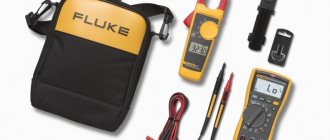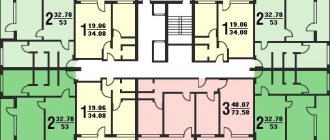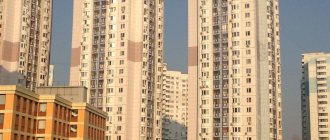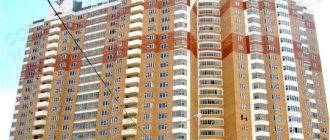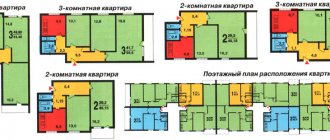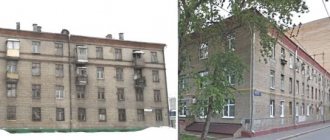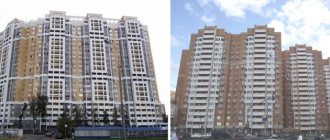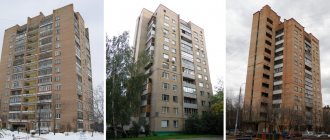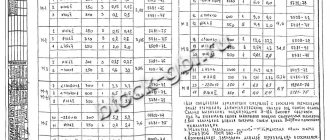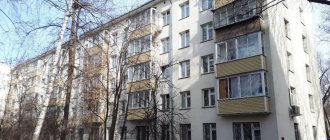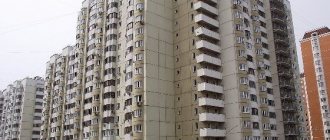II-32
- a series of panel five-story multi-section residential buildings, 85% of the houses were demolished, one of the first series of industrial housing construction, the basis of some areas of mass residential development of the 60s. A distinctive feature: the balconies rest on supports running from the foundation to the top floor. Houses of this and similar types were popularly called “Khrushchev buildings.”
Description
The houses have one-, two- and three-room apartments with separate and combined bathrooms, three apartments per floor. Ceiling height - 2.60 m. The external walls of the facades are made of vibrobrick panels (that is, from panels that were obtained by vibrationally pressing bricks and mortar at a preliminary stage, that is, at the factory) 320 mm thick (two bricks) with insulation from large-porous expanded clay concrete. Internal walls are vibrobrick panels made of one brick. Calculations showed that the load-bearing properties of vibrobrick panels are twice as high as those of a conventional brick wall, however, due to the smaller thickness and greater filling of voids with mortar, many of the positive properties of brick houses were lost. Ceilings and external end walls are reinforced concrete panels.
The houses do not have elevators, but there are garbage chutes. Heating, cold and hot water supply are centralized.
There is also a version of series II-32-130 houses with small apartments. There were several such houses on Zelenogradskaya Street and Novinki Street in Moscow. Currently, there is only one such house left in Novogireevo, which for some reason fell out of the demolition program. Houses in the 2nd and 3rd microdistricts of Zelenograd were also demolished. In this case, there are no balconies, the ends are blank, consisting of four white square panels, and the entrance can have 8-10 apartments per floor. Some of the facade panels have two narrow vertical windows - these are the windows of the kitchens of two neighboring apartments at the same time. There is also a version that has the shape of a staircase in plan (building 114 in Zelenograd). After the production of panels for series II-32 was completed, several dozen more houses with small-sized apartments, but with purely brick walls, were built (series I-511-130).
In addition to Moscow, they are found in certain cities of the Moscow region, but much less frequently than K-7.
Structural and planning diagram of houses of series ii-32, technical data
§ 6. Large-panel houses of the unified series II-32
For the first time, rolled floors and roofs were used in an experimental 5-story building with walls also made of rolled panels, built according to the MITEP project on Mira Avenue in Moscow. In this house, a longitudinal pitch of 3.2 m alternated with a pitch of 2.6 m, which resulted in reduced dimensions of the sanitary facilities with a bathtub 1.2 m long. In the same area, another experimental house was built from rolled panels, in which the pitch was 3, 2 m alternated with steps of 2.8 m; this made it possible to use sanitary cabins with a bathtub 1.5 m long. Based on the second experimental house, standard designs were developed, according to which a number of houses were built in New Kuzminki.
In order to reduce the number of standard sizes of prefabricated building products, the structural and planning scheme of houses of series ii-32 is designed with a single pitch of transverse load-bearing walls measuring 3.2 m with self-supporting external walls. The design of the house is based on the principle of interchangeability of both external and internal wall panels made of various materials; all other products (floors, roofs, stairs, balconies, cornice slabs and other elements) are used the same for all houses.
An important feature of the series is a single unified zero cycle for all houses with the same number of sections, regardless of the type of wall panels of the above-ground part of the building. In the houses of the universal series ii-32, the following options for wall design solutions are used: with external and internal walls made of vibrobrick panels; with external walls made of expanded clay concrete panels and internal walls made of flat reinforced concrete panels; with external and internal walls made of rolled panels.
The layout of the houses is based on three-apartment sections with a latitudinal orientation, each section has a length of 16 m; the width of the house is determined by two clear spans of 4.8 m (Fig. 3-6).
Rice. 3-6. Large-panel house made of vibro-brick structures, series ii-32
a - section plan; b - unit for supporting the floor panels on the transverse wall; c - vertical joint of external panels; 1— vibrobrick panel of transverse load-bearing walls; 2 - vibrobrick multilayer panel of external walls; ,3—lower ceiling panel of the interfloor floor; 4 — upper panel of the interfloor ceiling (floor panel); 5 - elastic gaskets; 6 - solution; 7 — foam glass insulation; 8 - load-bearing layer of brick 12 cm thick; ceramic cladding; 10 — sealing mastic; 11 - insulating package made of mineral wool boards
In houses of series II-32 there are separate type floors made of two rolled shells, facing each other with ribs and connected to each other through elastic gaskets laid along the perimeter of the panels (Fig. 3-6, b). The connection between the shells is ensured by welding of the embedded parts. The weight of the floor made from rolled panels is approximately 190 kg/m2.
In houses made of vibrobrick panels, external longitudinal self-supporting walls 25 cm thick consist of an outer layer of brick 12 cm thick, a 10 cm layer of foam glass insulation and an internal 3 cm layer of cement mortar (Fig. 3-6, c). In the panels of external end walls, the load-bearing layer of 1/2 brick, on which the ceilings rest, is located on the inside. Options for vibrobrick panels of external walls with insulation made of mineral wool slabs are possible. The internal transverse load-bearing vibrobrick panels are 14 cm thick.
In houses made of expanded clay concrete panels, self-supporting longitudinal walls, as well as load-bearing end walls, are 32 cm thick and are made of grade 50 concrete. Internal transverse load-bearing walls are made of reinforced concrete panels 12 cm thick; connection of panels of external and internal walls - by welding with embedding of nodes.
In houses made of vibro-rolled panels, the external and internal walls are made of two thin-walled rolled reinforced concrete shells, connected to each other by welding embedded parts. In external wall panels, usually made for two and three rooms, two layers of mineral wool boards with a total thickness of 10 cm are laid between the shells. In inter-apartment panels, a layer of soft fiberboards is laid between the shells to increase sound insulation.
<< Large-panel houses with walls made of vibrobrick panels
Large-panel houses of the MG-300 series >>
07.02.2014 [13:41 ]
This article has not yet been commented on. Inf-Repair will be grateful for the first comment about the article
Write a comment
* = required fields
Excerpt characterizing II-32 (series of houses)
- And what? - Oh, what a pig I am, however, that I never wrote and scared them so much. “Oh, what a pig I am,” he repeated, suddenly blushing. - Well, let’s go get some wine for Gavrilo! Well, okay, let's do it! - he said... In the letters of the relatives there was also a letter of recommendation to Prince Bagration, which, on the advice of Anna Mikhailovna, the old countess obtained through her friends and sent to her son, asking him to take it for its intended purpose and use it. - This is nonsense! “I really need it,” said Rostov, throwing the letter under the table. - Why did you leave it? – asked Boris. - Some kind of letter of recommendation, what the hell is there in the letter! - What the hell is in the letter? – Boris said, picking up and reading the inscription. – This letter is very necessary for you. “I don’t need anything, and I won’t go as an adjutant to anyone.” - From what? – asked Boris. - Lackey position! “You’re still the same dreamer, I see,” Boris said, shaking his head. – And you are still the same diplomat. Well, that’s not the point... Well, what are you talking about? - asked Rostov. - Yes, as you see. So far so good; but I admit, I would very much like to become an adjutant, and not remain at the front. - For what? - Because, having already started a career in military service, you should try to make, if possible, a brilliant career. - Yes, that’s how it is! - said Rostov, apparently thinking about something else. He looked intently and questioningly into his friend’s eyes, apparently searching in vain for a solution to some question. Old man Gavrilo brought wine. “Shouldn’t I send for Alphonse Karlych now?” - said Boris. - He will drink with you, but I can’t. - Go-go! Well, what is this nonsense? - Rostov said with a contemptuous smile. “He is a very, very good, honest and pleasant person,” said Boris. Rostov looked intently into Boris’s eyes again and sighed. Berg returned, and over a bottle of wine the conversation between the three officers became livelier. The guardsmen told Rostov about their campaign, about how they were honored in Russia, Poland and abroad. They told about the words and deeds of their commander, the Grand Duke, and anecdotes about his kindness and temper. Berg, as usual, was silent when the matter did not concern him personally, but on the occasion of anecdotes about the Grand Duke’s temper, he told with pleasure how in Galicia he managed to talk with the Grand Duke when he was driving around the shelves and was angry about the wrong movement. With a pleasant smile on his face, he told how the Grand Duke, very angry, rode up to him and shouted: “Arnauts!” (Arnauts was the crown prince’s favorite saying when he was angry) and demanded a company commander.
DC electric motors series P-31, P-32
Buy DC electric motors series P-31, P-32
DC motors
P 3 series are designed for long-term operation in DC electric drives in temperate, marine and tropical climates.
Electrical machines are manufactured with self-excitation. Electrical machines P31M, P32M have a shell design with a degree of protection IP23; machines PB31M, PB32M- IP54 DC electric motor P3: operating conditions DC electric motors
are designed to operate at ambient temperatures from minus 40ºC to plus 40ºC.
Relative ambient humidity 95±3% at a temperature of 20º±5ºC. Vibration, shock shocks, long-term tilts of the machine axis from 45º in any direction and when rolling up to 45º with a rolling period of 7-9 s. Excitation of DC electric motors P 3
independent, mixed, parallel, serial.
Insulation of DC electric motors P 3
heat resistance class B according to GOST 8865-87. The general level of airborne noise intensity and the level of vibration spectrum components of
P 3 DC electric motors
comply with approved standards.
DC motors
can withstand overcurrent:
- 2 In for 1 min. – stable voltage;
- 1.5 In for 2 minutes. – changing voltage;
- 4 In for 20 s.
Rated operating mode of P3 series DC motors
- long-term (SI according to GOST 183-74).
DC electric motors of the P3 series
allow operation in the following modes:
- short-term – S2
- intermittent – S3
Main parameters of P3 series DC motors
| Engine 's type | U=50 V | U=75B | U=110 V | U=220 V | ||||||||
| N, kW | I, A | n, rpm | N, kW | I, A | n, rpm | N, kW | I, A | n, rpm | N, kW | I, A | n, rpm | |
| P31M | 0,45 | 13,00 | 450 | 0,55 0,75 1,40 3,00 | 7,40 9,60 16,60 33,20 | 750 1000 1500 3000 | 0,55 0,75 1,40 3,00 | 3,60 4,61 8,07 16,50 | 750 1000 1500 3000 | |||
| PB31M | 0,45 0,65 1,30 | 5,50 7,40 14,00 | 1000 1500 3000 | 0,45 0,65 1,30 | 2,75 3,75 7,00 | 1000 1500 3000 | ||||||
| P32M | 0,80 1,10 2,20 4,20 | 10,00 12,94 24,50 45,00 | 750 1000 1500 3000 | 0,80 1,10 2,20 4,20 | 4,80 6,53 12,20 22,40 | 750 1000 1500 3000 | ||||||
| PB32M | 0,65 1,00 1,90 | 7,40 11,00 20,00 | 1000 1500 3000 | 0,65 1,00 1,90 | 3,70 5,50 10,00 | 1000 1500 3000 | ||||||
Overall and installation and connection dimensions of DC electric motors of the P3 series
| Machine type | Dimensions in mm | Weight in kg | |||||||||||||||||||||||
| L1 | L2 | L10 | L11 | L30 | L33 | h | h1 | h2 | h5 | h6 | h10 | h30 | h31 | b1 | b2 | b10 | b11 | d1 | d2 | d10 | d20 | d22 | d30 | ||
| P31M | 60 | — | 215 | 250 | 500 | — | 150 | 7 | 6 | 31 | 22,5 | 15 | — | 343 | 8 | 6 | 225 | 270 | 28 | 20 | 15 | 185 | M12 | 284 | 54,5 |
| P31M | 50 | — | 545 | ||||||||||||||||||||||
| PB31M | — | — | — | 500 | — | 320 | 50,4 | ||||||||||||||||||
| P32M | — | 260 | 295 | 545 | — | 343 | 62,5 | ||||||||||||||||||
| P32M | 50 | — | 591 | ||||||||||||||||||||||
| PB32M | — | — | — | 545 | — | 320 | 52,5 | ||||||||||||||||||
